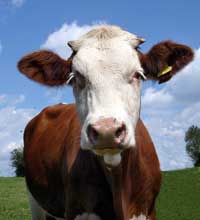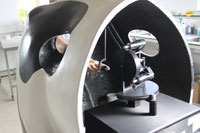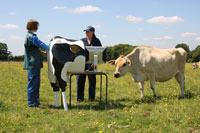Virtual reality: the Haptic Cow Inspire article
With the help of former vet, Sarah Baillie, Vienna Leigh takes us on a virtual reality trip – deep into a cow’s insides!

Have you ever wondered what the inside of a cow feels like? If you want to be a veterinarian, it’s something you’ll have to get very used to indeed! Vets often find themselves needing arm-length gloves for some of the more ‘hands-on’ parts of the job, but without visual indications it can be hard to teach veterinary students about what exactly they should be feeling for.
That’s where an ingenious invention by former vet Sarah Baillie, the Haptic Cow, comes in. “Haptic is a Greek word, relating to the sense of touch,” she explains. “The Haptic Cow is essentially a fibreglass model of the rear half of a cow that uses virtual reality to simulate the reproductive or rectal tracts of the animal.”
So, how does it work? “Your hand is suspended from a robotic arm positioned inside,” explains Sarah. “The motors of the arm control your hand movements and produce resistant forces, depending on which simulation is created via the software – a pregnancy, perhaps, or an ovarian cyst – and you get the impression of feeling objects in the abdomen and identifying them by their position, shape, size and texture or softness.”

Image courtesy of Peter Nunn
After inserting his or her arm through the rectum of the ‘cow’, the student will be instructed to feel forwards to the single ‘bump’ which is the cervix, and then further to the double bump that can only be the uterus. “If the cow is pregnant, pressing down on the side of the double or m-shaped bump of the womb will reveal to the student a thin wall and a watery feel,” explains Sarah. But be warned – press too hard or in the wrong place, and the Haptic Cow will utter a baleful ‘moo’!
It doesn’t stop at bovines, either. “I’ve also developed a Haptic Horse for which the simulations include common ailments of the digestive tract – colic, for example, which could be due to a twisted gut,” Sarah says. Moving a hand around the abdominal ‘landmarks’ teaches students how to tell the difference between, for example, a normal caecum (the beginning of the large intestine) – which feels ‘squishy’, according to Sarah – and constipation, which apparently feels more ‘doughy’. “For vets, learning or teaching how to do these kinds of manual diagnoses – which are often stressful, high-stakes events both for the animal and its owner – has always proved to be very difficult, because you can’t see what’s going on,” she says.
Sarah practiced as a vet for many years before a back injury meant she had to consider an alternative career.
A career as a vet requires a broad mix of abilities – a knowledge of science, technical competencies, clinical reasoning, and good communication and teaching skills, to name a few – and so Sarah had an unusual and useful skill set to take with her. While still working as a vet, she began to retrain in information technology (IT) – “I’d always been interested in computers, but I was of a generation where they were a very small part of my education” – and came across haptic technology during her MSc in IT at the University of Glasgoww1, UK. “Haptics create the illusion of feeling around 3D objects,” she says. “A few programmers had looked at using haptic technology to help doctors train (in keyhole surgery, for example) and I decided to see if I could use it to solve the problems I’d had teaching internal examinations of cows to vet students.”

face to face
Image courtesy of Peter Nunn
She embarked on a PhD focusing on using the technology to develop the Haptic Cow. “We now have a whole set of simulators for different species and techniques,” says Sarah, who, when she’s not inventing virtual reality innards, is a senior lecturer in veterinary education at the Royal Veterinary College, Londonw2 and a founder member of ViEWw3 (Veterinary Education Worldwide). “Most recently we’ve also developed haptic games to allow students to practice skills they’ll need for their clinical work in a fun, hands-on way.”
Sarah feels her experiences of the real issues faced in the workplace by vets have given her invaluable insight into the problems that research into education needs to solve. “The simulators I develop help to address the three Rs in veterinary education – to ‘reduce, replace and refine’ the use of animals in education,” she says. “The real animal or patient still has a vital role in a trainee clinician’s learning, but it helps to use alternatives to complement the traditional training methods where possible and appropriate.”
The haptic farmyard isn’t just restricted to the classroom, though; Sarah regularly takes her inventions to events, exhibitions and conferences. “The Haptic Cow has been at the Science Museum in London, and we were at the Royal Society’s Summer Science Exhibitionw4 this year,” she says. “Nearly 1500 people had a go on the simulators. It’s one of those technologies that still gets a ‘wow!’ reaction from people – after all, you’re feeling something that’s not really there!
Web References
- w1 – To learn more about the University of Glasgow’s department of computing science, see: www.dcs.gla.ac.uk
- w2 – To learn more about the Royal Veterinary College, see: www.rvc.ac.uk
- w3 – To learn more about ViEW, see: www.veteducation.org
- w4 – For more information about The Royal Society, the UK’s national academy of science, see: http://royalsociety.org
- For a video covering some of the exhibits at the Royal Society’s Summer Science Exhibition, see: http://news.bbc.co.uk/2/hi/science/nature/8125651.stm
Resources
- For a video of Sarah demonstrating the use of the Haptic Cow to identify pelvic landmarks and undertake pregnancy diagnosis and fertility tests, see: www.vetpulse.tv/associations-congress/bcva/61_sarah-baillie-haptic-cow-in-action
- More information about the Haptic Cow is also available on the website of LIVE (Lifelong Independent Veterinary Education): www.live.ac.uk/html/projects_haptic_01.html
Review
This interesting article explains how virtual reality helps veterinary students learn to examine the internal organs of the cow via its rectal or reproductive tracts. It would be particularly useful for biology teachers when teaching the topics of the digestive tract and reproductive systems. It could also be linked to virtual reality or simulation studies in computer technology lessons. For a more interdisciplinary approach, the article could provide the basis of a discussion on the use of information technology and computers in science and medicinal practice.
Andrew Galea, Malta





